Thibaut Chansac: Having just returned from a trip to Africa and heard about the ongoing white-winged gull influx in Western Europe, I was keen to pay a visit to the Bouqueval landfill site, situated less than 12.5 miles to the north of Paris.
It was around 10.15 am when I arrived at the rubbish piles on 21 February and the weather was perfect: no wind, fairly cold and sunny. More importantly, thousands of gulls were circling above the dump, and this looked promising. An advantage of this site is that I am allowed to climb on compactors that are not busy and they make for great observation platforms, and on that particular day a compactor was parked right in the middle of the waste. As I climbed on it, I found myself looking at dozens of large gulls just a few metres away with Black-headed Gulls passing by within arm’s reach, a perfect situation!
I set up my scope and proceeded to get my camera out the bag so that I would not waste time, should I come across a bird I would like to photograph. When I turned my camera on, however, the low battery signal was blinking – that was weird, as I knew it had half of the charge left the previous day. Never mind, I had another battery available. I replaced the flat battery with the new one and turned the camera on, only to see the low battery signal was still blinking! I tried to open the battery compartment and it appeared the damned battery was stuck. For the next 15 minutes, I desperately tried to get the battery out of its compartment but failed miserably. The incident forced me to realise the problem did not come from the battery but the camera itself. Well, so much for the pictures! I considered texting my friend and birding mate Stanislas Wroza "Wish that I don't find anything rare today, my camera is broken", but I couldn't find my phone either! In short, the weather was nice, there were plenty gulls to look at, but technology was not on my side.
Anyway, it was time to get back to actual birding and I started to scan through the flock with my scope. European Herring and Lesser Black-backed Gulls are the most numerous species of large gull at this time of the year, and that day was no exception. Quite a few Yellow-legged Gulls were also present and a couple of first-winter Caspian Gulls were easy to spot. Of course, the place was flooded with Black-headed Gulls, while the occasional Mediterranean Gull could be heard calling in the melee.
After no more than 10 minutes I noticed a small group of birds, composed mainly of adult Lesser Black-backs, about 50 m away, busy wrangling over a piece of meat. Looking through my scope, my attention was drawn to an adult or near adult bird making its way out the melee with a mouthful of meat. It was facing me and coming towards my position. The piece of meat it was carrying was so big that its head was almost totally concealed, except for its upper mandible, and that mandible looked unusually thick for a Lesser Black-backed Gull. The bird kept on walking slowly through the numerous Black-headed Gulls with its spoils. I suddenly had a strange thought: "Well it's not like it will turn out to be a Kelp Gull" and started looking for other stuff – yes, I did that!
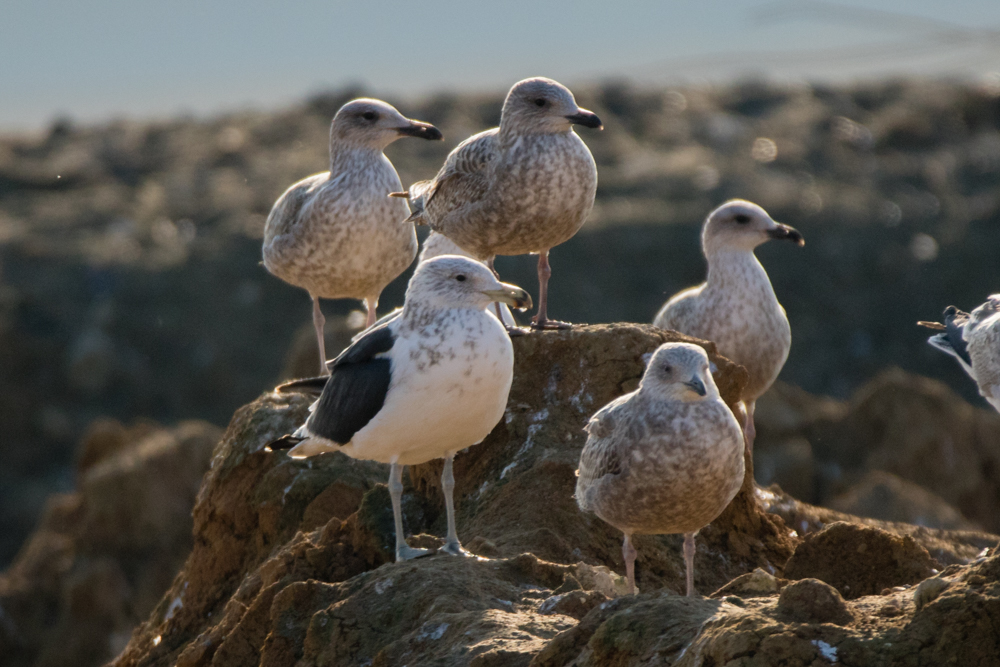
Kelp Gull (front left) with European Herring Gulls, Bouqueval landfill site, Val-d'Oise, France, 22 February 2018 (Thibaut Chansac).
However, after no more than a couple of seconds, my instinct made me turn the scope back to where I had seen that peculiar bird. I had a nagging feeling of unfinished business and thought that perhaps I should double check. Just as I had relocated the bird, easily recognisable thanks to its meal, a Herring Gull came running towards it, obviously seeking to steal the meat. Both birds flew away from me, with the Herring in hot pursuit of the other bird. I was following them with my binoculars when they disappeared behind a sand pile. Fortunately, they quickly reappeared on the other side of the pile, racing to the eastern part of the dump, and they soon became backlit.
While keeping track of them with my naked eyes, I pondered what I had seen. Although it had happened in a flash, the gull I was focusing on seemingly had a fairly large white trailing edge to the wing and did not look smaller than the Herring, but that was possibly wishful thinking. The chase had been on for a minute when the subject gull suddenly dropped its meal. It looked very disillusioned as it watched the Herring Gull swooping to snatch its quarry. It drifted lazily for a few seconds then turned toward me and the rubbish piles, and finally landed only 25 metres away from me. I grabbed my scope for the final check-up, convinced that I was about to see yet another Lesser Black-backed Gull. I looked through my scope, and my heart sank … The bird was standing perfectly broadside, nicely lit by the low winter sun. The thick bill stood out like a sore thumb. It certainly wasn't a Lesser Black-backed, and it really looked like a Kelp Gull – a bird I had encountered on a few occasions in Africa, although my last sighting was over a decade ago. I was completely dumfounded. I had a potentially monster rare bird right next to me, and my camera was out of order.
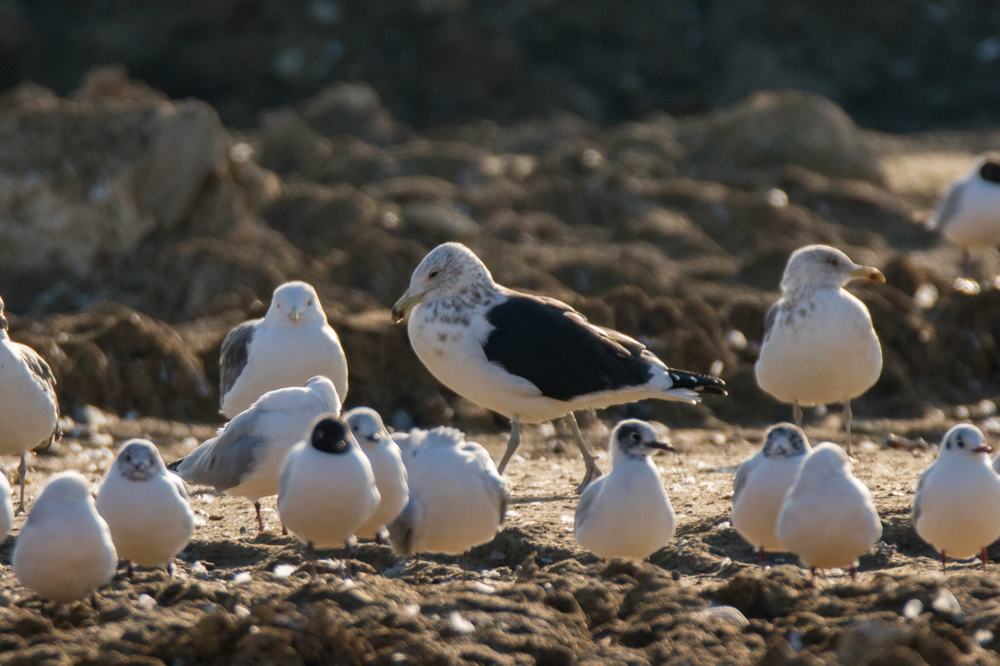
Thibaut's first profile view of the Kelp Gull revealed a stocky bird with short wings, dark eye, broad white tips to the secondaries and a robust bill, as this photo taken the following day shows (Thibaut Chansac).
I decided to make the best out the situation and check as many features as I could, which wasn`t difficult with the bird so close: the mantle was darker than the LBBG in the vicinity, the structure was noticeably stocky with fairly short wings, the eyes were dark, the white tips of the secondaries were standing out even with the wings folded (the so called 'skirt'), although the white tips to the primaries were on the other hand quite small, with only one tiny mirror on p10 effectively ruling out a Great Black-backed Gull. It was also showing some signs of immaturity in the form of dark markings to the tail and bill – the latter being also too dull yellow for an adult bird – along with heavy dark blotching to the head and neck. I was so thunderstruck that it took me a while to remember that one of the main distinguishing feature of adult and sub-adult Kelp gull is the greenish colour of the legs. Focusing on those, I was first surprised to see they were rather yellowish. Still, I knew all too well this colouring could come from the soil of the landfill. Indeed as I pushed the magnification of the scope I could clearly see that, not only most of the legs were covered in mud, but also that the upper tibia were clean, and those were clearly showing a pale greenish tinge. All the features were adding up and pointing to Kelp Gull. Yet, the main problem remained: if I were to claim a Kelp Gull in the outskirts of Paris, I needed evidence!
Then I had a sudden flash of inspiration: get my phone and try to phonoscope the bird. I climbed off the compactor and rushed to my car. As it was nowhere to be found, I realised that I had left it at the reception of the landfill. The only solution left was to borrow the smartphone of a local worker. And that I did! The fella of course had a look of surprise but he kindly agreed to let me use his phone. I rushed back to the compactor, climbed on it on the opposite side of the main flock so I wouldn`t scare the birds off. I was relieved to see 'it' was still there. From then on, I clumsily tried to phonoscope the bird, and to cut a long story short, I failed. After several minutes of unsuccessful and nerves fraying attempts, the gull vanished in a massive take-off of the flock feeding on the tip. That left me in deep despair. I could not believe my camera had let me down at the worst possible moment.
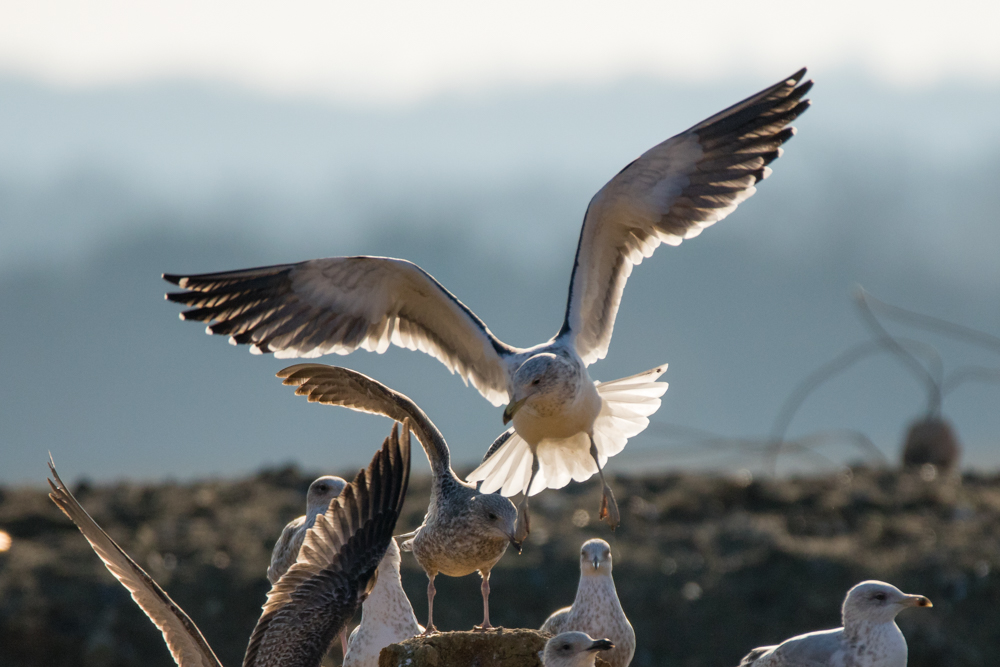
The Kelp Gull coming in to land on 22 February 2018, showing the tiny white mirror on p10 only (Thibaut Chansac).
Having returned to the reception of the landfill and got my phone back, I settled down for a bit of '2.0 birding' and started looking for pictures of Kelp Gull on the web. This actually had the funny consequence to let the doubt creep in. Indeed, while I could find quite a few similar-looking immature Kelp Gull pictures, none were showing the heavy head and neck blotching I had seen on the bird.
I chatted with Stan on messenger and told him what had just happened. I also chatted briefly with Irish birder Harry Hussey who was online, told him the story and sought advice regarding the head pattern. I was making plans with Stan for the next day, which involved obtaining a pass for him as I was so far the only birder allowed to enter the tip, when Stan asked: "What if I could join you now?". Half an hour later I texted Stan the following message: "We have a meeting with the staff in an hour. Can you make it?"
Stanislas Wroza: When I arrived at the dump, Thibaut was waiting for a meeting with the staff. We talked about his sighting for about 20 minutes, which was enough for me to understand that he was both puzzled and desperate about this mysterious Kelp-like Gull. He was already expressing some doubts about what he had really seen. There were thousands of Gulls flying around everywhere and even big flocks leaving the area, which meant that we had virtually no chance of stumbling on the bird again. At this time we didn't realise that we were still just at the beginning of a journey that should probably go down as the longest day in the French gulling history.
We spent almost the whole afternoon on the core activity of the landfill finding nothing more than a dozen Caspian Gulls. The birds were very mobile and there was a remarkable turn-over. Yet, as time went by, we noticed that several hundred birds were roosting in a field outside the landfill. We decided to drive there to check the flock. The road was so extremely muddy that we expressed some concerns about whether we were going to be able to drive our way back through it. After reaching our destination, we screened all the gulls several times and concluded that there was nothing exciting among them, even though the birds were sleeping in the distance.
Very close to the field, there was a little pond with a few dozen large gulls bathing in it, and among them we found an Iceland Gull. This is true local rarity being only the second-ever county record, so I took some time to take pictures. As I was taking photos of that bird, I heard Thibaut's voice shouting: "What on earth are you doing with your camera? It's flying just above your head!" Actually, we were looking at different birds – ridiculously, there were two Iceland Gulls on that pond! This was further evidence that anything could happen there at the time …
As the dusk was approaching, we went back to the field where the gulls were still sleeping and there was still nothing suspicious. Suddenly, the flock took off and it was like an electric shock for us. A massive bill emerged from the feathers of an oddly-structured black-backed gull that immediately disappeared flying in the distance, allowing us no time to react. We could only complain about our negligence: "It was just there and we missed our last chance to put a name on it."
In the spur of the moment, we decided to drive straight to the core activity area to try our last bit of luck. But in the middle of the rush, it didn't even take us 10 seconds to get the car stuck deeply in the mud. Ten additional seemingly endless minutes passed during which we put a few stones under the wheels in order to miraculously get ourselves out of the mess just before dusk. A nervous laughter hit us as we thought about the elements seeming being aligned against us since the beginning of the day.
We stopped at the top of the landfill, scanning all the birds around. The light was decreasing quickly and the number of gulls was fading away as well – there was nothing to see except thousands of Black-headed Gulls. As we were going to give up, Thibaut, startled and trembling, tried to utter a few words like "There…it…just there…the". He didn't manage to end its sentence but with the naked eye I could see the infamous gull standing on a pile of sand, just as it had come out of nowhere. With my hands starting to shake, I grabbed my camera, shut my brain off and shot over 100 consecutive pictures. Only then did we start to realise what had just happened. We watched night fall on this crazy bird, that really did show all the features of a Kelp Gull. A look at the open wings pictures was petrifying: this tiny mirror on p10 was perfect.
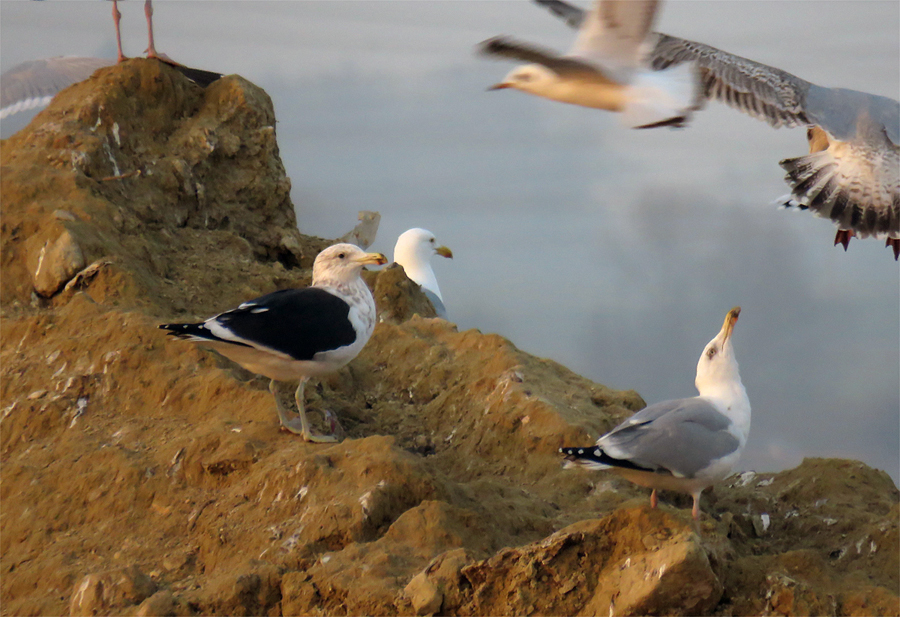

After a long and stressful afternoon of chasing it around, Stan finally managed to document the Kelp Gull with the two images below which, even on their own, confirm the identity beyond any doubt (Stanislas Wroza).
Thibaut Chansac: The pictures Stan managed to take were sent to several well-known gull aficionados, including Belgian birder Peter Adriaens and Wisconsin based Amar Ayyash, for confirmation. They all agreed on the identification without any reservation.
A handful of lucky twitchers were able to see the Kelp Gull the following day when, after six hours of intense searching, it was relocated by myself on the very same pond that had held the two Iceland Gulls the previous day. Stan and myself had even the unique opportunity to watch this amazing bird down to 30 m for several minutes, a most exhilarating experience.
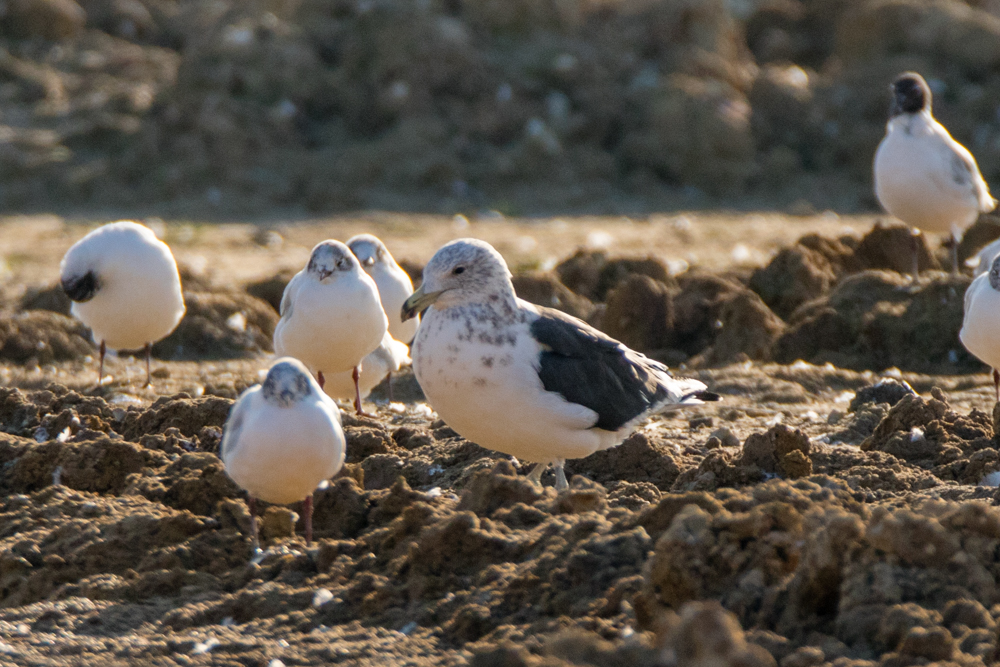
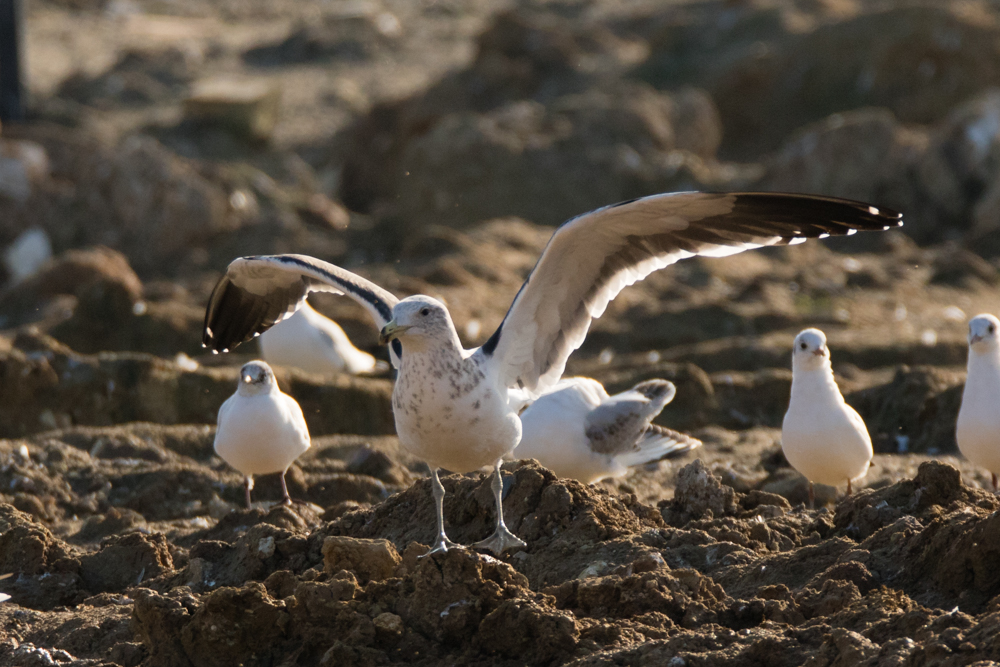
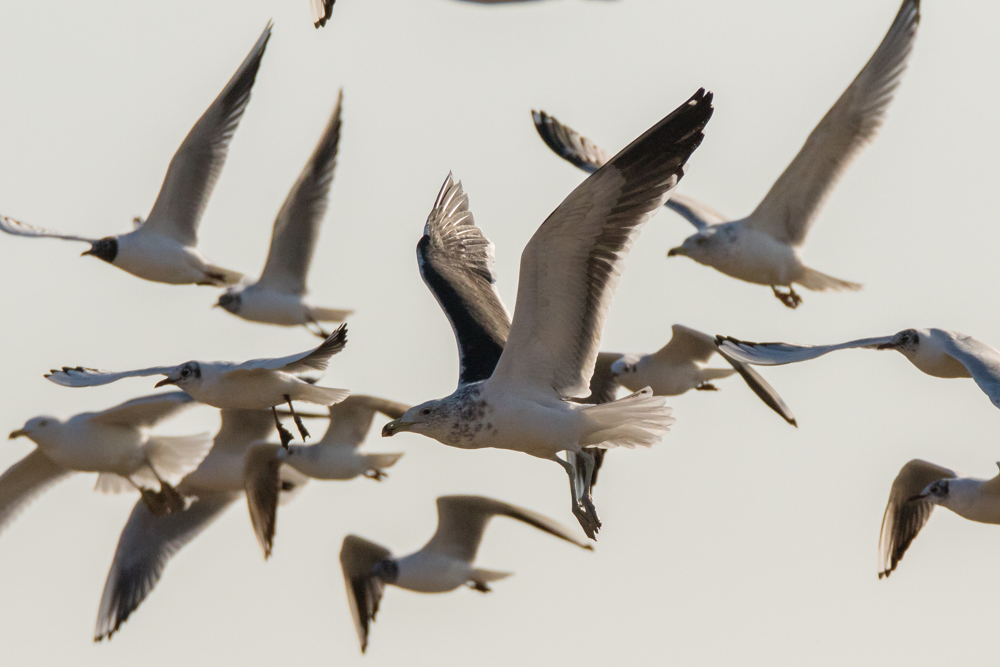
Kelp Gull, Bouqueval landfill site, Val-d'Oise, France, 22 February 2018 (Thibaut Chansac).



